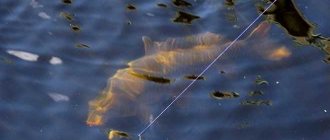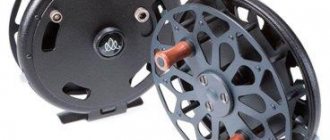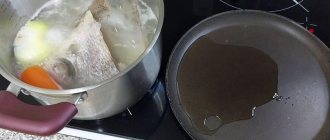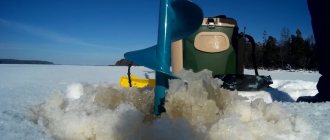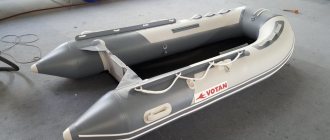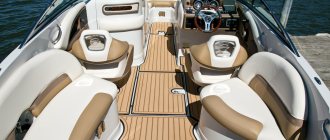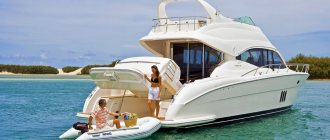Telescopic rod device
Main parts of the telescope:
- form;
- lever;
- reel seat;
- pass rings.
Form
The form consists of several, usually 3–7, separate parts (sections, knees). When the rod is folded, they fit into each other. To unfold the gear, you need to pull them out and securely fix them. In this case, you need to make sure that the throughput rings are on the same line.
The design of the blank is the main difference between a telescopic fishing rod and a plug rod. The last knees are separated from each other when the fishing rod is disassembled. When assembling such gear, one section is inserted into another.
Passing rings
The passage rings on the telescope are located at the end of each bend.
The exception is often the first section, which does not have a ring. Its installation on the first knee may be unnecessary. If you place a guide ring here, the line will come off the reel at too sharp an angle, resulting in a reduced casting distance. Also, such a sharp angle would interfere with fishing. The last, end leg of a telescopic rod usually has two, and sometimes even 3, rings. At the tip there is a tulip - a special access ring, which, unlike the others, does not stand perpendicular to the form, but at an angle of 120 degrees to it. The tulip gives the line direction during casting.
One or two floating guides slide close to the tulip when the rod is folded. They are necessary so that the load is better distributed over the last knee. Also, an additional “floating” ring can be on the second knee.
Lever
Telescopic fishing rods do not differ from plug-in fishing rods in terms of handles and reel seats. The handles of modern gear are made of cork or neoprene.
Cork is a “warm” material that does not cool your hands even at subzero temperatures. Many people like it both to the touch and in appearance. The advantage of cork is that it is easy to clean and does not accumulate dirt.
But keep in mind that there are different types of this material that differ in quality. If we are talking about a budget telescope, then the cork from which the handle is made can cause more disappointment than positive emotions.
Neoprene, like cork, is a warm material. Its advantage is that neoprene is cheaper than cork. Even if you choose an inexpensive telescopic rod, the neoprene handle is likely to be durable and durable. The disadvantage of neoprene is that it collects dirt that is difficult to wash off.
Reel seat
Screw reel seats are usually used. They securely fix the reel. There are screw reel seats of different levels, cheap and expensive, which are installed on telescopic rods of low and high price categories.
Another option is Clip Up reel seats, also called quick-release or quick-release reel seats. Placed on Bolognese rods. The advantage of such a reel seat is that it allows you to very quickly remove or install the reel, and it has minimal weight.
Criterias of choice
There is no doubt that when choosing fishing equipment, you should give preference to purchasing with a known quality, and this is guaranteed by a product from a well-known brand, purchased from a reliable retail outlet. The choice of telescopic spinning rod begins with an inspection of the knee joints, the number of which can vary from three to nine elements. Having spread the rod to its full length, check the blank for rigidity by shaking the spinning rod. In a reliable thing, there are no backlashes and inaudible extraneous sounds. The form should not be noodles. If the quality of the tool is normal, the angler will feel the tension of the tackle without any failures in movement.
Important! It is worth paying attention to the accuracy of fitting the rings, which should not move when unfolding, touch each other and bend when folding the gear.
It is preferable to choose a spinning rod with a cork handle and a reel seat made of a light metal alloy, which can at least somehow affect the reduction in weight of the equipment. Having completed the visual inspection and making sure that there are no visible defects, they determine the operating parameters of the spinning rod, selecting the version suitable for the expected fishing conditions. In this direction, the fisherman should highlight the criteria for determining the optimal length of the tackle, the material used to make the rod blank, its structure and test parameters. These values depend on the type of bait used, the type of reservoir being fished and the structure of the coastline, which affects casting, the intensity and methodology of the fishing method. It is on these selection parameters that we will dwell in more detail in the continuation of the article, pointing out to the angler the possible options for choosing.
Material of manufacture
Telescopic spinning rods, like many other fishing equipment, are made from composite plastic materials that differ in the variants of binding components represented by different types of polymers. The most widely used materials for making fishing rods are fiberglass, carbon fiber, also known as carbon, and composite. Fiberglass telescopes are considered reliable and non-fragile, resistant to dynamic loads and at the same time flexible. But the big disadvantage of fiberglass is its weight. Telescopic spinning rods made of fiberglass are heavy and quickly tire the angler’s hand. Although, their so-called oakiness helps in the fight against powerful fish and has a positive effect on casting distance.
Carbon fiber tackle is much lighter than fiberglass, more sensitive and has better balance, but is fragile. Such tackle requires careful care of the form. After all, sand that gets on the fishing rod and, as a result of folding the telescope, scratches the surface of the material, renders the fishing rod unusable. The price of carbon fiber telescopes is high. The best option is to purchase a composite spinning rod, which, in terms of material properties, is intermediate between the examples presented above. It is reliable, undemanding to operating conditions, and the cost is in the rank of budget gear.
Test values
The test values of the telescopic stick are chosen based on what baits the angler most often intends to use during fishing. It’s worth mentioning right away that you’re unlikely to find this type of gear in ultralight, but in the range of medium and heavy class versions of telescopic spinning rods, there’s more than enough. These are the ones you should focus on when planning to purchase tackle of this design.
Typically, telescopes are labeled with test values in grams, ounces or pounds. The range indicated on the form will indicate the optimal weight of the baits used for fishing, which should not be neglected, especially when going beyond the upper limits, to avoid overloading the gear, which is already sensitive to loads due to the large number of joints. In the middle class, the optimal range is 10–30 grams. It is more rational to buy a more powerful rod with 20-50 grams. Such values cover a significant mass of baits suitable for catching freshwater predators.
Length
The length of a spinning telescope should be selected based on the conditions of the planned fishing. Such conditions include where the angler will cast the bait from. For example, shore fishing is significantly different from fishing done from a boat. In turn, coastal fishing may also have differences. Coastal fishing conditions vary depending on the structure and presence of thickets in the coastal zone from which casts are made. If the clean shore comes close to the water area of the reservoir without the presence of coastal and coastal thickets of reeds, bushes and trees with a crown hanging over the water, then for long-range spinning rods with the longest blank are selected. Under such conditions there are no obstacles to the swing. If there is a tree crown nearby or close to suitable bushes and reeds, throwing the bait with long tackle is inconvenient and risks the bait getting caught on obstacles.
Fishing from a boat is limited by the space of the vessel, and range fades into the background, due to the fact that you can swim close to a promising point. Therefore, for cramped conditions, hunting from a boat and inconveniences, telescopes with a length of 1.6 to 2 meters are selected. When hunting from ideal positions, look for gear with a blank length of 2.1–2.7 meters.
Important! Long telescopic spinning rods are flimsy and quickly fail as a result of irreparable play in the maple joints.
Build
The ability of the blank to bend without affecting its strength is called the structure of the tackle. There are three main characteristics of fishing rods for this parameter: fast, medium and slow. The spinning rod is selected according to the formation based on the animation control of the baits.
Important! The stiffer the blank, the better it is to control the play of the wobbler, silicone and spinner.
But at the same time, with rigid tackle it is more difficult to catch large fish, which can break the rod that does not absorb shocks. Telescopic spinning rods are easiest to find in medium action, since the design features, and in particular, the heterogeneity of the blank due to the large number of joints, do not allow ideal balancing of the tackle for fast, and even more so slow action. Telescopic versions of medium-action spinning rods are universal in use and allow you to comfortably and efficiently work with many types of baits without fear of equipment breakage. An average spinning rod in the test will cover most fishing conditions.
Advantages and disadvantages of telescopic rods
There is no single answer to the question of which is better – a telescopic rod or a plug rod. The choice depends on both the type of fishing and personal preferences. Flying rods are telescopic, while match and feeder rods are plug-in. The lap dogs are available in a telescopic version. Thus, when fishing with these tackles, the question of which design to choose practically does not arise.
But spinning rods come in both telescopic and plug-in types. And here it is worth carefully weighing the arguments for and against both options in order to decide on a purchase.
Advantages of telescopes
Telescopic rods have significant advantages that attract beginners and those who fish infrequently.
Compactness. When folded, many telescopes do not exceed half a meter in length. This is typical for spinning rods. Such rods are much more convenient to transport than plug-in, two-legged rods, which when disassembled are more than a meter long.
Cheapness. There are many inexpensive telescopic rods, primarily for spinning rods, but also for other types of fishing. Plug-in gear is usually more expensive.
Advantages of plugs
In many respects, plugs are superior to telescopic rods.
Build. If telescopic rods are almost always soft and lame, then the plugs often have an ultra-fast, fast or medium-fast action. These are rigid sticks that provide accurate casts and sharp hooks, and also allow you to confidently control the fish while playing. Plug-in fishing rods perform better on casting and retrieving than telescopic rods.
It is also important that rings can be placed at any points on the plug form. This is what manufacturers do; as a result, the load is distributed across the gear in an optimal way. In the case of a telescopic rod, the rings can only be located at the ends of the knees.
Sensitivity. The plugs better transfer into the hand everything that happens with the bait, which is especially important in spinning fishing. Telescopic fishing rods are inferior in this regard. Weight. With the same material of manufacture, the same length and the same number of guide rings, a telescopic rod will be heavier than a plug rod.
Plug-in or telescopic spinning rod – which is better?
A plug rod has both advantages and disadvantages. The first include the following properties:
- Casting accuracy.
- Good visual and tactile sensitivity.
- High rigidity for hooking when lifting the catch.
- Light weight.
- The length of the plug spinning rod allows you to fish from almost any position.
- Wide selection of models.
The main disadvantage of a plug-in spinning rod is the impossibility of repair if the rod body breaks. The only option for returning to fishing after this may be to replace the spinning rod.
In addition, owners of these fishing rods are faced with the large size of double-armed and one-piece plug models, which forces them to make special cases made of plastic pipes for their storage and allocate a special place for them at home or in the car.
In order to determine which is better - a plug-in or telescopic spinning rod, you need to analyze the properties of the second type of fishing rod.
So, a telescopic fishing rod has the following advantages:
- Maintainability due to replacement of connecting rings or component blank elements.
- The dimensions of the assembled rod are compact for transportation.
Otherwise, these rods are inferior to their plug-in “opponents”.
Types of fishing
Flywheel
Fly fishing rods are only telescopic. This design is well suited for this type of gear. The rigidity and strength of such a fishing rod is sufficient for catching small and medium-sized fish. Fly fishing rods are usually used to hunt for such trophies.
Bologna
Bolonki are also usually made in the form of telescopes. The exception is a few models of plug-in lap dogs, which can also be found on the shelves. But they are rarely found in stores and are practically never used.
Plug Bolognese fishing rods were invented in Great Britain, where it often rains. On a plug blank, the guide rings can be placed closer to each other than on a telescopic rod. Thanks to this, wet fishing line sticks to the blank much less.
In the climate typical for domestic open spaces, a lap dog of a telescopic design meets the needs of the fisherman, and there is no need to use a plug.
Donnaya
Specialized feeder and carp fishing rods are manufactured in a plug-in design. This design provides them with power at low weight and good performance in fishing.
But telescopic rods are also often used for bottom fishing. These are usually inexpensive composite spinning poles. They perform all the tasks assigned to them, coping with both casting bottom rigs and hooking and fishing. Such inexpensive telescopic rods are well suited for catching small and medium-sized fish.
Since their price is low, you can buy 2, 3 or 4 of these fishing rods at once, and this will not require much expense. Using several donks at the same time increases the chances of good catches. The traditional advantage of telescopic rods - compactness and ease of transportation - comes in handy in this case.
Spinning
You can always find inexpensive spinning telescope rods on sale. They will satisfy the needs of anglers who are undemanding about their gear and who do not spend much time catching predators. The low cost and compactness of such telescopes when transporting them attract many people.
But in spinning fishing, the quality of the rod and its good performance are still much more important than in bottom fishing. Therefore, advanced anglers definitely prefer plug-in two-part rods to telescopic rods. Such spinning rods are inferior in their performance properties only to single-piece spinning rods.
There is a third option for spinning gear - expensive telescopes, which may well satisfy even experienced fishermen. They are suitable for those who need gear that takes up minimal space during transportation. Such compact telescopic fishing rods, for example, are very convenient to take with you when traveling.
Trolling
Separately, it is worth considering trolling rods. The throwing qualities of such gear are not important, and heavy weight is also not a problem. The main thing is that the stick is powerful enough to cope with the landing of the trophy, and that it handles the fish well when playing. That is why telescopic gear is often used for trolling.
Their “noodleiness” when trolling fishing is not a problem, but rather turns out to be a plus. Such “soft” sticks best absorb the jerks of the fish. Since trolling often produces trophies of decent weight, the importance of this quality is difficult to overestimate. For fishing in freshwater bodies, inexpensive but powerful telescopic spinning rods are suitable. Special trolling telescopes are used for sea fishing.
How to choose a telescopic fishing rod in a store
How to choose the right telescopic fishing rod for fishing in a store? First, review the information on the form. Here are the length, test and other characteristics with which you should start choosing a stick.
It doesn’t hurt to take a tape measure with you to the store and measure the gear you like. Even with expensive telescopic fishing rods, the actual size may differ significantly from the declared one. This difference sometimes exceeds half a meter. By measuring the rod you like before purchasing with a tape measure, you will avoid unpleasant surprises.
You can also weigh a telescopic fishing rod before purchasing. Sometimes manufacturers underestimate the weight of a fishing rod to make it more attractive in the eyes of potential buyers.
To determine the structure of the tackle, you need to take it by the handle and shake it. The actual system also does not always correspond to what is stated.
- Ultra-fast action telescopic rods bend at the top quarter.
- Fast - a third of the length.
- Medium - bend from the middle.
Slow-action telescopes bend almost along their entire length, starting from the handle. You should not only shake the fishing rod in different directions, but also draw circles in the air with the tip. Good tackle will bend equally in different directions, without squeaks or rattles. Of course, you should count on quality only if you buy rather expensive gear. For many cheap telescopes, squeaks and rattles are normal.
Also carefully inspect the tackle you like, checking for cracks, burrs, and eliminating asymmetry and curvature. The cheaper the rod, the higher the likelihood that it will have such problems. But even among expensive gear there are sometimes defects.

